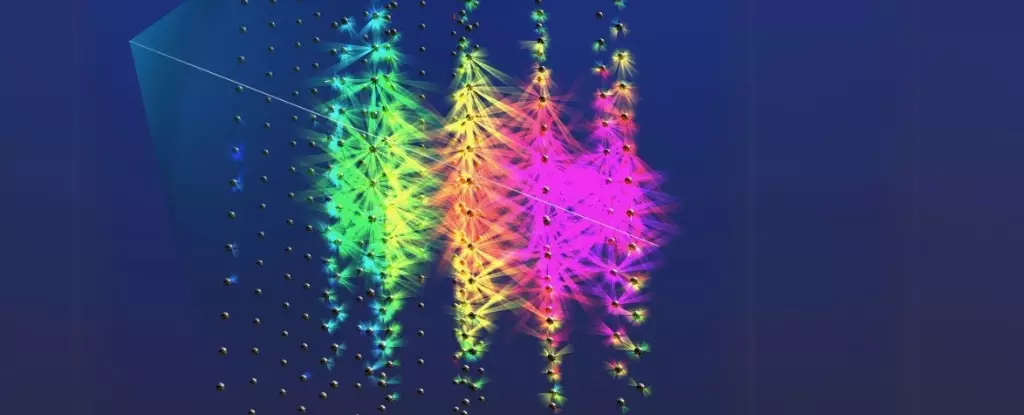In the vast expanse of the universe, high-energy particles rain down on Earth, often unnoticed due to their elusive nature. Neutrinos, fundamental particles that roam freely and interact minimally with matter, are the stars of this phenomenon. Recently, scientists made a groundbreaking discovery that has reignited interest in particle astrophysics: the detection of a neutrino with an astonishing energy level far beyond any previously recorded. On February 13, 2023, a sophisticated detector located beneath the Mediterranean Sea off the coast of Sicily detected this unprecedented event, which could have profound implications for our understanding of the cosmos.
This exceptional neutrino was measured at an astonishing 220 petaelectronvolts (PeV) – dwarfing the earlier record-holder, which registered a mere 10 PeV. This leap in energy prompts a flurry of questions regarding the origins of these particles, as only a select few cosmic entities possess the capabilities to energize particles to such extremes. Notable candidates include supernova explosions, which occur at the end of a star’s life cycle, and supermassive black holes that exhibit extraordinary activity.
Among the potential sources, blazars—a unique class of active galaxies featuring supermassive black holes emitting powerful jets of radiation—have emerged as strong contenders. These jets, aimed almost directly at Earth, could serve as accelerators for the neutrino detected. However, the sheer magnitude of energy observed raises the intriguing possibility that this could also be the first instance of a cosmogenic neutrino being detected; if true, this would signify a fundamental discovery in astrophysics. Such neutrinos may arise from cosmic rays interacting with the cosmos’s leftover radiation from the Big Bang, intertwining two fundamental aspects of our universe’s history.
Neutrinos are fascinating yet enigmatic particles. With no electric charge and an almost negligible mass, they travel through particles at nearly the speed of light, making them vastly abundant yet incredibly difficult to observe. Every second, billions pass through our bodies unnoticed, highlighting their elusive presence. Their weak interaction with matter makes detection a formidable challenge—this is typically accomplished through large volumes of mediums such as water or ice, where researchers can observe the faint light flashes produced by neutrino interactions.
In this recent detection, the neutrino was observed by the KM3NeT (Cubic Kilometer Neutrino Telescope) array, submerged 3,450 meters deep in the Mediterranean. This network consists of hundreds of modules, each equipped with numerous light-sensitive detectors designed to capture the fleeting flashes that indicate a neutrino event. During the notable observation in 2023, the KM3NeT detectors recorded over 28,000 photons—each a remnant of the interactions initiated by the high-energy neutrino’s passage, illuminating the otherwise dark surroundings.
Determining the origin of such an energetic neutrino is no simple task. The nature of neutrinos allows them to journey vast distances unimpeded, complicating efforts to trace their sources. As researchers sift through potential origins, they generally classify them into different categories: astronomical events within our galaxy, those local to the Universe, transient cosmic events, and distant extragalactic sources. Interestingly, upon investigating the sky region from which the neutrino originated, the team found little support for a source from within our galaxy, steering the focus toward an extragalactic origin.
Amongst the possible culprits, active supermassive black holes take center stage. Researchers identified a list of potential blazar candidates in the vicinity, producing a blend of 12 candidates. However, as the authors of the study noted, no definitive connection could yet be established. The sheer number of blazars populating the sky means that further observational campaigns and studies are paramount for conclusive identification.
An additional line of inquiry centers around the concept of cosmogenic neutrino production. This theory posits that such high-energy neutrinos result from cosmic rays colliding with background radiation from the events that transpired in the early universe. If the newly detected neutrino indeed belongs to this category, it would mark a pivotal moment in neutrino research and the broader understanding of cosmic phenomena.
The implications of this observation extend beyond the immediate understanding of high-energy astrophysics; they could reshape our comprehension of the universe’s evolution, its structure, and the relationships between various cosmic entities. As scientists forge ahead with further investigations, the cosmic mystery surrounding the record-breaking neutrino invites curiosity and speculation, holding the promise of unlocking new realms of knowledge in our quest to understand the universe we inhabit.


Leave a Reply